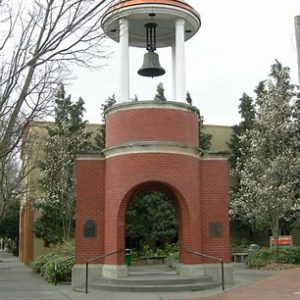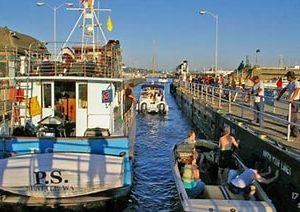A Walk in the ‘Hood
On Thursday I led a walking tour of Ballard, our Seattle neighborhood.
It was the first of a “neighborhood walks” series, the latest idea of our great civic entrepreneur, David Brewster. David has been the founder of Seattle Weekly, Town Hall Seattle and Crosscut.com among other things. His current project is Post Alley.
His idea was for one neighborhood walking tour, each month, in one of Seattle’s ‘hoods. I offered to lead off as we will soon head back to the Wallowas in Oregon for the balance of the summer.
We had about 20 people show up. And we had a good time as we trekked a three mile route I had laid out. District 6 City Council Member Dan Strauss, joined us. Dan is a born and bred native of Ballard, so he added both interesting historical notes as well as updates on some current issues.
We gathered at the Ballard library, two blocks north of Ballard’s main east/west thoroughfare, Market Street, and kitty-cornered from the Ballard Commons. That park is almost entirely a homeless tent encampment, as are the sidewalks and portico on the north and west sides of the library.
From there we headed south to Market St., and west a couple blocks, turning south onto Ballard Avenue. (At right the Bell Tower on the site of the original Ballard Town Hall on Ballard Avenue.)
 Ballard Avenue is perhaps the most upscale part of the neighborhood, boasting a number of fine restaurants and retail stores. Of course, the pandemic has trimmed its sails, but many of the restaurants have outside, “cafe,” seating. Dan Strauss indicated that may well become a continuing feature. Paris comes to Ballard! There’s also has a great live music scene here, just coming back to life now. It includes places like The Tractor Tavern and The Sunset with “Betty’s Room.”
Ballard Avenue is perhaps the most upscale part of the neighborhood, boasting a number of fine restaurants and retail stores. Of course, the pandemic has trimmed its sails, but many of the restaurants have outside, “cafe,” seating. Dan Strauss indicated that may well become a continuing feature. Paris comes to Ballard! There’s also has a great live music scene here, just coming back to life now. It includes places like The Tractor Tavern and The Sunset with “Betty’s Room.”
One of the many interesting things about Ballard is that it was an independent city, the second largest in King County at the turn of the twentieth century. In 1907 it voted, on the second vote, for annexation by Seattle. Seattle had the fresh water supply Ballard needed. In that era Ballard boasted the largest concentration of log and shingle mills of any town on the west coast. The early 20th century economy was booming. Fishing, logging and shingles for houses.
 Still today Ballard is a real mix of industry, retail, office and residential. The industry ranges from “Salmon Bay Sand and Gravel,” to nine active boatyards, where boats are taken out of the water for servicing and rebuilding. All this is a big parts of old, working class Ballard with its concrete trucks, gravel barges, shipyards and fishing boats. (Boats going through the Ballard Locks to the Sound at right.)
Still today Ballard is a real mix of industry, retail, office and residential. The industry ranges from “Salmon Bay Sand and Gravel,” to nine active boatyards, where boats are taken out of the water for servicing and rebuilding. All this is a big parts of old, working class Ballard with its concrete trucks, gravel barges, shipyards and fishing boats. (Boats going through the Ballard Locks to the Sound at right.)
Alongside that is “new Ballard,” the kind of stores and restaurants that are on Ballard Avenue and Market Street. There are also lots of new apartment buildings for people who work in nearby downtown at Amazon. 4-plex townhouses are making in-roads into the single-family home neighborhoods that extend north above Market Street to North Beach.
Our walk turned off Ballard Avenue, south down Center St. where the railroad used to run, back when it ended in Ballard. Hence the name, “Ballard Terminal Railroad,” a short line that still exists. We emerged into the heart of the industrial area. Along the way a couple of business owners came out to see what we were up to. They ended up telling us about their businesses, taking the chance to bend Councilmember Strauss’s ear a bit in the process.
That stretch of Shilshole Avenue has been a point of contention between old and new Ballard. It’s the so-called “missing link” on the City’s Burke-Gilman Bike Trail. Industry doesn’t want it the bike trail. Recreational and commuters bikers and walkers do.
From there we continued, beneath the Ballard Bridge, east to a new area of commercial and retail development dubbed “the Ballard Blocks.” It includes a fancy Puget Consumer’s Coop, Trader Joe’s, and soon, an Amazon cash-free grocery store. Also a new Kaiser Clinic, fitness centers and a big new Western Marine Supply store. Back in the hey-day of “Grunge” and “Metal” music, key recording studios were located in that area.
Because of all the industry here a number of low cost, space-hungry operations, like brew pubs, found a home in Ballard. At last count we had 55 brew pubs here. If the old rule of thumb was “one church for every tavern,” the taverns/ pubs have long since won that race!
We did some fancy dancing by Quest Church, a large liberal evangelical, multi-racial, multi-cultural church, on Leary, to get to Java John shop on Leary. Patty Jahn has run her coffee shop there for 28 years. After coffee we headed back uptown continuing west to our end point at the new National Nordic Museum. If you haven’t been there, I recommend a visit. Beautiful and informative.
When we moved to Ballard six years ago, from the southeast part of Seattle, I was struck by the difference from the park-like, fresh-water Lake Washington shoreline (an Olmstead Brothers design) to the working waterfront here on the saltwater of Puget Sound. While I missed the park-like feel of the neighborhoods along the Lake, the mix of uses, users and activity here in Ballard is fascinating.
Jane Jacob’s the great twentieth century urbanist argued for such mixes, and against the more mono-cultural neighborhoods that Robert Moses was then imposing on New York. Jacobs later lived in Toronto, where we spent a year a decade ago. Toronto, thanks in part to her efforts has retained that interesting cheek-by-jowl mix. Consider Ballard “Toronto On the Sound!”
Since moving up from the south Lake Washington area, I’ve grumped some about Ballard’s noise and grittiness. Our walk made me appreciate Ballard more, seeing it on it’s own terms and for what it is, rather than for what it isn’t. If you live in Seattle and are interested in David’s series of walks, let me know and I’ll put you in touch with him.
![Anthony B. Robinson [logo]](https://www.anthonybrobinson.com/wp-content/themes/anthonybrobinson/images/logo.png)
![Anthony B. Robinson [logo]](https://www.anthonybrobinson.com/wp-content/themes/anthonybrobinson/images/logo-print.png)